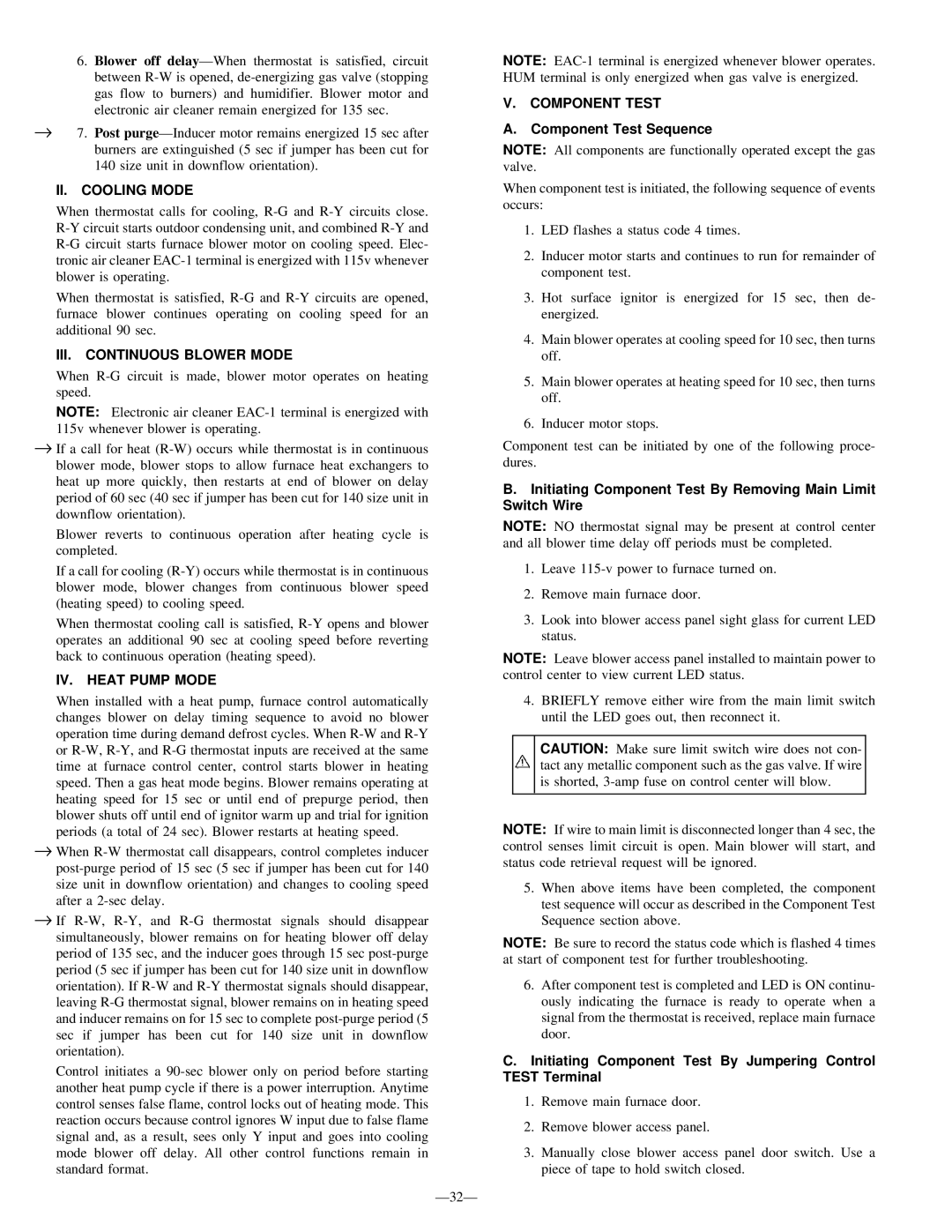6.Blower off delayÐWhen thermostat is satisfied, circuit between R-W is opened, de-energizing gas valve (stopping gas flow to burners) and humidifier. Blower motor and electronic air cleaner remain energized for 135 sec.
→7. Post purgeÐInducer motor remains energized 15 sec after burners are extinguished (5 sec if jumper has been cut for 140 size unit in downflow orientation).
II.COOLING MODE
When thermostat calls for cooling, R-G and R-Y circuits close. R-Y circuit starts outdoor condensing unit, and combined R-Y and R-G circuit starts furnace blower motor on cooling speed. Elec- tronic air cleaner EAC-1 terminal is energized with 115v whenever blower is operating.
When thermostat is satisfied, R-G and R-Y circuits are opened, furnace blower continues operating on cooling speed for an additional 90 sec.
III.CONTINUOUS BLOWER MODE
When R-G circuit is made, blower motor operates on heating speed.
NOTE: Electronic air cleaner EAC-1 terminal is energized with 115v whenever blower is operating.
→If a call for heat (R-W) occurs while thermostat is in continuous blower mode, blower stops to allow furnace heat exchangers to heat up more quickly, then restarts at end of blower on delay period of 60 sec (40 sec if jumper has been cut for 140 size unit in downflow orientation).
Blower reverts to continuous operation after heating cycle is completed.
If a call for cooling (R-Y) occurs while thermostat is in continuous blower mode, blower changes from continuous blower speed (heating speed) to cooling speed.
When thermostat cooling call is satisfied, R-Y opens and blower operates an additional 90 sec at cooling speed before reverting back to continuous operation (heating speed).
IV. HEAT PUMP MODE
When installed with a heat pump, furnace control automatically changes blower on delay timing sequence to avoid no blower operation time during demand defrost cycles. When R-W and R-Y or R-W, R-Y, and R-G thermostat inputs are received at the same time at furnace control center, control starts blower in heating speed. Then a gas heat mode begins. Blower remains operating at heating speed for 15 sec or until end of prepurge period, then blower shuts off until end of ignitor warm up and trial for ignition periods (a total of 24 sec). Blower restarts at heating speed.
→When R-W thermostat call disappears, control completes inducer post-purge period of 15 sec (5 sec if jumper has been cut for 140 size unit in downflow orientation) and changes to cooling speed after a 2-sec delay.
→If R-W, R-Y, and R-G thermostat signals should disappear simultaneously, blower remains on for heating blower off delay period of 135 sec, and the inducer goes through 15 sec post-purge period (5 sec if jumper has been cut for 140 size unit in downflow orientation). If R-W and R-Y thermostat signals should disappear, leaving R-G thermostat signal, blower remains on in heating speed and inducer remains on for 15 sec to complete post-purge period (5 sec if jumper has been cut for 140 size unit in downflow orientation).
Control initiates a 90-sec blower only on period before starting another heat pump cycle if there is a power interruption. Anytime control senses false flame, control locks out of heating mode. This reaction occurs because control ignores W input due to false flame signal and, as a result, sees only Y input and goes into cooling mode blower off delay. All other control functions remain in standard format.
Ð32Ð
NOTE: EAC-1 terminal is energized whenever blower operates. HUM terminal is only energized when gas valve is energized.
V.COMPONENT TEST
A. Component Test Sequence
NOTE: All components are functionally operated except the gas valve.
When component test is initiated, the following sequence of events occurs:
1.LED flashes a status code 4 times.
2.Inducer motor starts and continues to run for remainder of component test.
3.Hot surface ignitor is energized for 15 sec, then de- energized.
4.Main blower operates at cooling speed for 10 sec, then turns off.
5.Main blower operates at heating speed for 10 sec, then turns off.
6.Inducer motor stops.
Component test can be initiated by one of the following proce- dures.
B.Initiating Component Test By Removing Main Limit Switch Wire
NOTE: NO thermostat signal may be present at control center and all blower time delay off periods must be completed.
1.Leave 115-v power to furnace turned on.
2.Remove main furnace door.
3.Look into blower access panel sight glass for current LED status.
NOTE: Leave blower access panel installed to maintain power to control center to view current LED status.
4.BRIEFLY remove either wire from the main limit switch until the LED goes out, then reconnect it.
CAUTION: Make sure limit switch wire does not con- tact any metallic component such as the gas valve. If wire is shorted, 3-amp fuse on control center will blow.
NOTE: If wire to main limit is disconnected longer than 4 sec, the control senses limit circuit is open. Main blower will start, and status code retrieval request will be ignored.
5.When above items have been completed, the component test sequence will occur as described in the Component Test Sequence section above.
NOTE: Be sure to record the status code which is flashed 4 times at start of component test for further troubleshooting.
6.After component test is completed and LED is ON continu- ously indicating the furnace is ready to operate when a signal from the thermostat is received, replace main furnace door.
C.Initiating Component Test By Jumpering Control TEST Terminal
1.Remove main furnace door.
2.Remove blower access panel.
3.Manually close blower access panel door switch. Use a piece of tape to hold switch closed.

